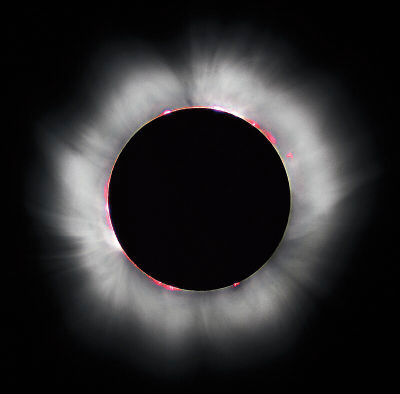METRO DETROIT — The sun and moon will trace a path across North America Monday, April 8, bringing a total solar eclipse to a large swath of the United States.
The path of totality — the line across Earth along which the sun and moon will be in lockstep, and the moon will completely block out the sun — will fall across a tiny sliver of southeast Michigan. The last time North America experienced a total solar eclipse was 2017, and the last time Michigan experienced a total eclipse was 1954.
"Get thee to the path of totality, " University of Michigan astronomer and physicist David Gerdes said in a press release. “It will be another 75 years — 2099 — before Michiganders glimpse another total solar eclipse.”
Both types of eclipses happen when the moon passes directly in front of the sun. By an amazing cosmic coincidence, the moon's diameter is 400 times smaller than the sun, and the sun is about 400 times farther away. So, as seen from Earth, they have almost the same apparent size, and the moon can almost exactly cover the sun. But the moon's orbit isn't perfectly circular. Its apparent diameter varies by about 12% as it moves around its elliptical orbit. This is enough to make a difference between fully covering the sun, which is a total eclipse, and not-quite-covering the sun, an annular, or "ring of fire," eclipse.
“Because the sun isn't completely covered in an annular eclipse, the spectacular sights of a total eclipse — the delicate solar corona, darkness in the middle of the day, 360-degree twilight around the horizon — are not visible,” wrote Gerdes. “Fortunately for us, the April 8, 2024, total eclipse will occur when the moon's apparent size is near its maximum, so people in the path of totality will be treated to a total eclipse that lasts over four minutes, nearly twice as long as the total eclipse of 2017.”
The total eclipse will be observable in a small fraction of space in southeastern Michigan. The rest of the area will view the celestial event as am annular eclipse.
“The path of totality will pass just about an hour south of Ann Arbor, through northern Ohio,” wrote Gerdes. “People in the Ann Arbor area will experience a very deep partial eclipse of about 98.5%. The surroundings will become noticeably dimmer, colors will appear flat and shadows will be sharper than usual. You may observe changes in nature, with animals, birds and insects displaying evening behavior. The temperature may drop 10 degrees or so. You may be able to spot Venus in the daytime sky a bit west of the sun.
He also urged caution when viewing an eclipse of any kind.
“It's very important to note that a 98.5% partial eclipse is a zero-percent total eclipse,” Gerdes wrote. “The remaining 1.5% of the sun is still very bright. At no point will it be safe to look directly at the sun without eye protection. You will not be able to see the solar corona or other amazing sights of totality like the Diamond Ring Effect or Baily's beads. If it's at all possible for you, I encourage you to make your way into the path of totality to see one of nature's most awe-inspiring sights. Most of us will not have the opportunity to view another total eclipse this close to home in our lifetime—the next total eclipse visible from Ann Arbor isn't until 2099.”
Except during the total eclipse itself, which will last about four minutes, Gerdes said anyone viewing it must wear eye protection when looking directly at the sun. Eclipse glasses are made with very dark film and are an inexpensive way to keep your eyes safe. They are so dark that it blocks anything less bright than the sun.
“You can also use a homemade pinhole projector — just a piece of cardboard with a small round hole punched in it — to safely project an image of the sun onto the ground,” Gerdes wrote. “A kitchen colander is also great for this. Or you can use natural pinhole projectors, such as the spaces between the leaves of a tree that provided a lovely view of the annular eclipse last October.”
 Publication select ▼
Publication select ▼























